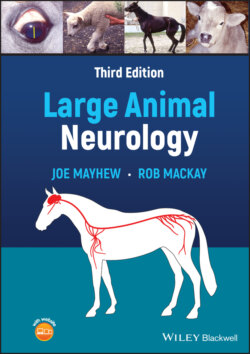Читать книгу Large Animal Neurology - Joe Mayhew - Страница 28
Behavior
ОглавлениеThe owner or handler will frequently be the best source of information regarding the patient’s behavior, and age, breed, and sex will influence expected response patterns. Occasionally, auditory and tactile stimulation can elicit seizure activity. Focal and mild generalized seizures in neonatal animals may be seen as episodes of repetitive jaw champing, facial twitching, or periods of tachypnea. Bizarre and inappropriate behavior, such as head pressing, compulsive wandering, circling, changes in voice and appetite, and licking objects and aggressiveness, is usually easy to recognize. Other more subtle behavioral abnormalities, such as continual yawning, can be regarded as signs of cerebral disease. An animal with a forebrain lesion that compulsively circles tends to do so toward the side of the lesion.
It is often difficult for a clinician to distinguish between behavioral aberrations associated with organic forebrain disease and compulsive or stereotypic disorders in which no morbid neurologic lesion can usually be identified (see Figure 2.5). Characteristics of behavioral disorders defined as seizures can be mistaken for altered mentation alone such as sleep disorders (see below) and syncope of cardiac origin, and these need to be identified and differentiated. The former two are far more frequently encountered than syncope, although the separation of those two syndromes can be difficult. Other signs of forebrain disease such as an asymmetric menace response, asymmetric sensation perceived from the nasal septum, and asymmetric forelimb hopping all can add to the confidence of a diagnosis of asymmetric forebrain disease resulting in multiple seizures (epilepsy) as opposed to a diagnosis of a sleep disorder. With true narcolepsy in large animals, a prominent degree of cataplexy or loss of all muscle tone is usually seen, and thus recumbency and recovery are most frequently quiet events as opposed to the tonic and clonic situation with epilepsy. Seizures and sleep attacks both tend to occur more often during quiet times, although both may be associated with precipitating factors such as being released into a paddock, feeding, grooming, and other forms of presumably pleasant manipulation. Indeed, strong evidence for focal seizures that do not fully generalize (i.e., do not cause recumbency) has been encountered in racehorses during preparation for and after racing. These have tended to involve facial grimacing, followed by head, neck, and even forelimb jerky movements.
